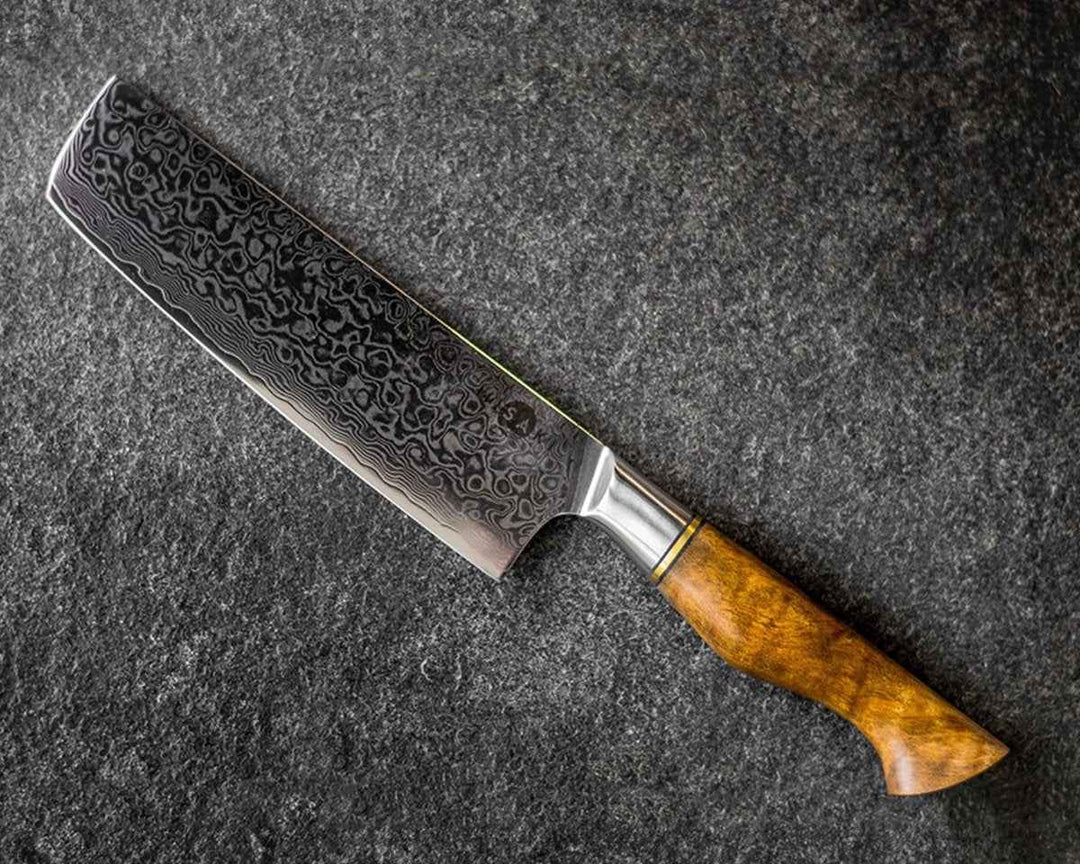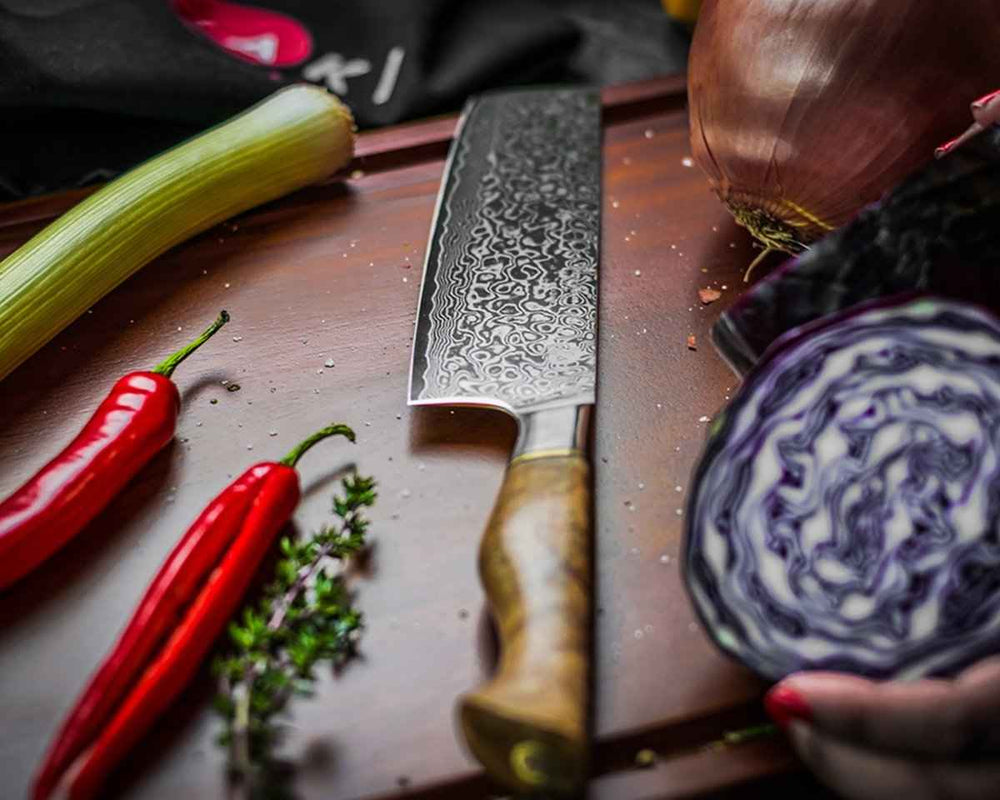Nakiri knives: cutting vegetables with the highest precision
The MISAKI Nakiri knife combines Japanese tradition with modern design. The wide, straight blade made of 67 layers of Damascus steel glides effortlessly through vegetables and herbs, allowing for clean, even cuts – ideal for raw vegetables, diced vegetables, and fine strips. Handcrafted with a sophisticated sycamore handle, it impresses with perfect balance and maximum comfort.
A Japanese nakiri knife isn't just a cutting tool. It's a statement of culinary perfection and aesthetics. Whether for your own kitchen or as a gift: Be enchanted by the unparalleled quality and elegant design of MISAKI knives!
The noble Nakiri knife from MISAKI
The Japanese word "nakiri" translates as "leaf cutter." The nakiri knife is designed for cutting vegetables, raw vegetables, and herbs.
Our Nakiri knife is available exclusively in the Hikari line . Like all knives in this line, its blade is made of 67 layers of Damascus steel with a hardness of 60 to 62 HRC, allowing you to make clean cuts. The knife's comfortable handle is made of amber-colored sycamore maple.
In addition to the individual version, the Nakiri is also part of selected sets, for example in a duo with a Santoku or in combination with a chef's knife - the perfect addition for versatile cutting tasks.
Each of our Damascus knives is unique because it is masterfully handcrafted. This is evident in the individual grain of the blade, which is typical of Damascus knives. Upon request, we can engrave your Nakiri knife, transforming it into a truly personal work of art.
How do you properly care for a Nakiri knife?
Proper care of a Nakiri knife preserves its sharpness, beauty, and longevity. After each use, you should carefully clean the blade by hand with warm water and mild detergent. Aggressive cleaning agents and the Dishwasher -safe. Dry thoroughly afterward to avoid rust stains.
To keep your Nakiri knife sharp, we recommend gradual care. For everyday use, it's sufficient to regularly sharpen the edge with a diamond sharpening rod – this will quickly correct any slight blunting. If the knife has become significantly blunt, use a wet whetstone (1000/6000 grit) . Use the coarse side to restore the basic sharpness, and the fine side to refine the edge. For the perfect finishing touch, run the blade over a leather strop , which removes any remaining burrs and polishes the edge.
Treatments with our camellia oil reliably protect the blade from corrosion and preserve the elegant grain of the Damascus steel. Store your knife safely in a knife block , on a magnetic holder , or in a matching sheath to prevent damage to the blade. This way, your MISAKI Nakiri knife remains a precise and elegant tool for vegetable-based cooking.
FAQ zu Nakiri
+
A nakiri is a traditional Japanese vegetable knife with a thin, rectangular blade and a straight edge. It is specifically designed for slicing and chopping vegetables and is characterized by its precision and efficiency.
+
A Nakiri knife is perfect for slicing, chopping, and dicing all kinds of vegetables. Thanks to its flat blade, you can effortlessly glide through the vegetables and achieve even cuts.
+
A nakiri knife is an essential tool for all lovers of Japanese cuisine and for those who value precision and aesthetics. It offers a unique combination of traditional design and modern performance.
+
A high-quality nakiri knife allows you to prepare vegetables more efficiently and precisely, enriching your cooking experience and helping you create impressive dishes. It's a must-have for anyone who values quality and craftsmanship.
+
The Nakiri's tall blade keeps your fingers away from the cutting board while cutting, allowing you to chop vegetables more safely and comfortably. The wide, straight edge allows the blade to rest completely on the board, resulting in clean, even cuts without pulling or tugging. At the same time, the wide surface can be used for sliding or transferring ingredients. All of this makes the Nakiri particularly efficient and precise when cutting vegetables.
+
A nakiri knife is specifically designed for finely slicing vegetables and herbs. It is therefore only suitable for meat to a limited extent. While it can cut thin slices of tender meat, the blade quickly reaches its limits when cutting bones or tough meat.
If you are looking for the highest precision and safety when cutting meat, you should choose achef's knifeor aSantoku knifeThe nakiri remains the first choice for vegetables—a masterpiece of plant-based cuisine.
+
When purchasing a Nakiri knife, there are several crucial factors that determine quality, functionality, and durability:
- First and foremost, the blade steel is crucial. High-quality Damascus steel ensures sharpness, stability, and rust resistance. The edge should be fine but robust and ideally hand-ground.
- The blade profile also plays a role. A flat, straight edge allows for precise, clean cutting of vegetables. Equally important is the handle, which should be ergonomically shaped, non-slip, and comfortable to hold.
- Ultimately, craftsmanship and balance are what count. A well-balanced Nakiri knife sits securely and comfortably in the hand, making it a reliable partner in any kitchen.
The MISAKI Nakiri from the HIKARI line meets all these criteria: 67 layers of Damascus steel, 60–62 HRC hardness, and a handcrafted handle made of fine sycamore maple – ideal for a durable vegetable knife with the highest precision.






